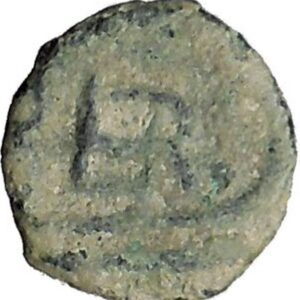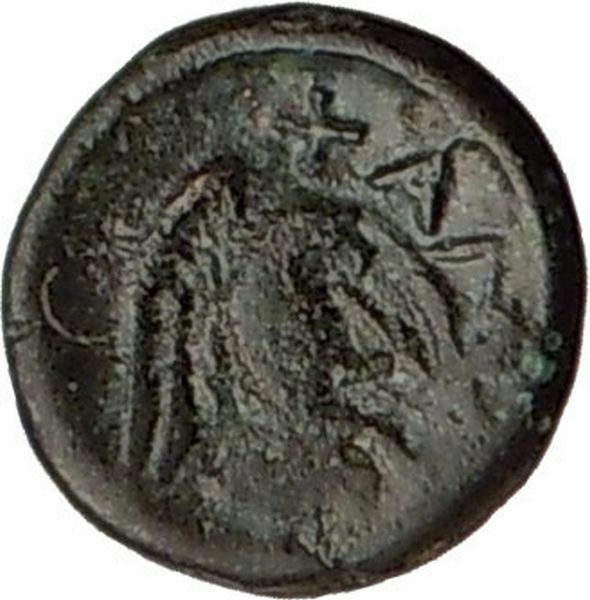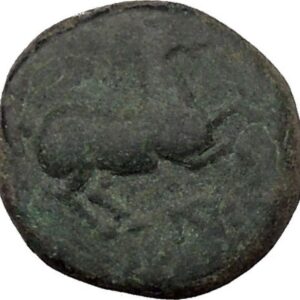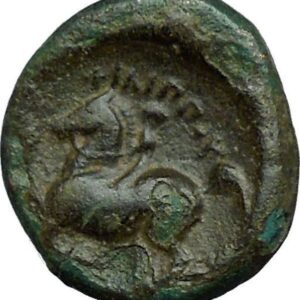|
Lysimachos – King of Thrace, Asia Minor and Macedonia: 323-281 B.C. –
Bronze 21mm (5.97 grams) Lampsakos mint: 305-281 B.C.
Reference: Müller pl. 11, 13. Sear 6818.
Helmeted head of Athena right.
ΛΥΣIMAXOY / BAΣIΛEΩΣ, either side of trophy.
One of the most remarkable of the ‘Successors’ of Alexander, Lysimachos was
of Thessalian stock and was a bodyguard of the great Macedonian King. In the
confused period following Alexander’s death he obtained the government of
Thrace, and in 309 B.C. founded his capital city of Lysimacheia where many of
his coins were struck. In 305 B.C. he took the title of King, and four years
later extended his rule over much of Asia Minor following the defeat of
Antigonos the One-eyed at Ipos. His later years were marred by domestic tragedy
and his harsh rule made him unpopular with his subjects. In 281 B.C. Lysimachos,
now aged 80, was attacked by Seleukos of Syria who was only two years his
junior. Lysimachos died fighting at the battle of Korupedion and his kingdom
disappeared with him. But his memory lived on and generations later a number of
mints in the Black Sea area restored his coin types for their autonomous issues.
You are bidding on the exact item pictured,
provided with a Certificate of Authenticity and Lifetime Guarantee of
Authenticity.
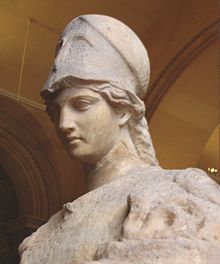
Helmeted Athena with the cista and Erichthonius in his serpent form.
Roman, first century (Louvre
Museum)
In
Greek religion
and
mythology
, Athena or Athene, also
referred to as Pallas Athena/Athene , is the goddess of wisdom, courage,
inspiration, civilization, law and justice, just warfare, mathematics, strength,
strategy, the arts, crafts, and skill.
Minerva
is the
Roman goddess
identified with
Athena.
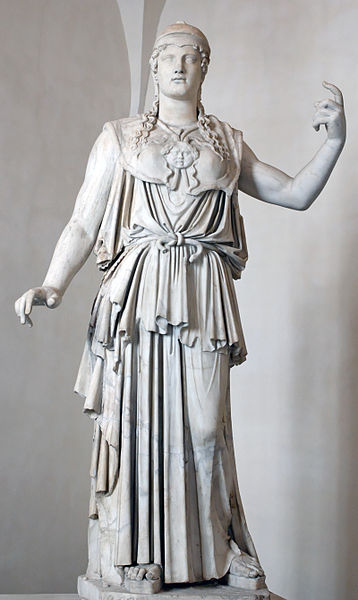
Marble Greek copy signed “Antiokhos”, a first century BC variant of
Phidias
‘
fifth-century
Athena Promachos
that stood on the
Acropolis
Athena is also a shrewd companion of
heroes and is the
goddess
of heroic endeavour. She is the
virgin
patroness of
Athens
. The Athenians founded the
Parthenon
on the Acropolis of her namesake
city, Athens (Athena Parthenos), in her honour.
Athena’s veneration as the patron of Athens seems to have existed from the
earliest times, and was so persistent that archaic myths about her were recast
to adapt to cultural changes. In her role as a protector of the city (polis),
many people throughout the Greek world worshiped Athena as Athena Polias
(Ἀθηνᾶ Πολιάς “Athena of the city”). The city of
Athens
and the goddess Athena essentially bear
the same name, “Athenai” meaning “[many] Athenas”.
Patroness
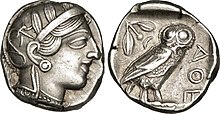
Athenian
tetradrachm
representing the
goddess Athena
Athena as the goddess of philosophy became an aspect of the cult in Classical
Greece during the late 5th century B.C. She is the patroness of various crafts,
especially of weaving
, as Athena Ergane, and was
honored as such at festivals such as
Chalceia
. The metalwork of weapons also fell
under her patronage. She led battles (Athena
Promachos or the warrior maiden Athena Parthenos) as the
disciplined, strategic side of war, in contrast to her brother
Ares, the patron of violence, bloodlust and slaughter—”the raw force
of war”. Athena’s wisdom includes the cunning intelligence (metis) of
such figures as Odysseus
. Not only was this version of Athena
the opposite of Ares in combat, it was also the polar opposite of the serene
earth goddess version of the deity, Athena Polias.
Athena appears in Greek mythology as the patron and helper of many heroes,
including Odysseus
,
Jason
, and
Heracles
. In
Classical Greek
myths, she never consorts with
a lover, nor does she ever marry,earning the title Athena Parthenos. A
remnant of archaic myth depicts her as the adoptive mother of
Erechtheus
/Erichthonius
through the foiled rape by
Hephaestus
. Other variants relate that
Erichthonius, the serpent that accompanied Athena, was born to
Gaia
: when the rape failed, the semen landed on
Gaia and impregnated her. After Erechthonius was born, Gaia gave him to Athena.
Though Athena is a goddess of war strategy, she disliked fighting without
purpose and preferred to use wisdom to settle predicaments.The goddess only
encouraged fighting for a reasonable cause or to resolve conflict. As patron of
Athens she fought in the Trojan war on the side of the Achaeans.
Athena
Parthenos: Virgin Athena
Athena never had a consort or lover and is thus known as
Athena Parthenos
, “Virgin Athena”. Her most
famous temple, the
Parthenon
, on the
Acropolis
in
Athens
takes its name from this title. It is
not merely an observation of her virginity, but a recognition of her role as
enforcer of rules of sexual modesty and ritual mystery. Even beyond recognition,
the Athenians allotted the goddess value based on this pureness of virginity as
it upheld a rudiment of female behavior in the patriarchal society. Kerenyi’s
study and theory of Athena accredits her virginal toponym to be a result of the
relationship to her father Zeus and a vital, cohesive piece of her character
throughout the ages.
This role is expressed in a number of stories about Athena.
Marinus of Neapolis
reports that when
Christians removed the statue of the Goddess from the
Parthenon
, a beautiful woman appeared in a
dream to Proclus
, a devotee of Athena, and announced
that the “Athenian Lady” wished to dwell with him.
Judgment of Paris

Aphrodite is being surveyed by Paris, while Athena (the leftmost
figure) and Hera stand nearby.
El Juicio de Paris
by
Enrique Simonet
, ca. 1904
All the gods and goddesses as well as various mortals were invited to the
marriage of Peleus
and
Thetis
(the eventual parents of
Achilles
). Only
Eris
, goddess of discord, was not invited. She
was annoyed at this, so she arrived with a golden apple inscribed with the word
καλλίστῃ (kallistēi, “for the fairest”), which she threw among the goddesses.
Aphrodite, Hera, and Athena all claimed to be the fairest, and thus the rightful
owner of the apple.
The goddesses chose to place the matter before Zeus, who, not wanting to
favor one of the goddesses, put the choice into the hands of Paris, a
Trojan prince. After bathing in the spring of
Mount Ida
(where Troy was situated), the
goddesses appeared before Paris. The goddesses undressed and presented
themselves to Paris naked, either at his request or for the sake of winning.

Paris is awarding the apple to Aphrodite, while Athena makes a face.
Urteil des Paris by
Anton Raphael Mengs
, ca. 1757
Still, Paris could not decide, as all three were ideally beautiful, so they
resorted to bribes. Hera tried to bribe Paris with control over all
Asia and Europe
, while Athena offered wisdom, fame and
glory in battle, but Aphrodite came forth and whispered to Paris that if he were
to choose her as the fairest he would have the most beautiful mortal woman in
the world as a wife, and he accordingly chose her. This woman was
Helen
, who was, unfortunately for Paris,
already married to King
Menelaus
of
Sparta
. The other two goddesses were enraged by
this and through Helen’s abduction by Paris they brought about the
Trojan War
.

The Parthenon
, Temple of Athena
Parthenos
Masculinity and
feminism
Athena had an “androgynous compromise” that allowed her traits and what she
stood for to be attributed to male and female rulers alike over the course of
history (such as Marie de’ Medici, Anne of Austria, Christina of Sweden, and
Catherine the Great)
J.J. Bachofen advocated that Athena was originally a maternal figure stable
in her security and poise but was caught up and perverted by a patriarchal
society; this was especially the case in Athens. The goddess adapted but could
very easily be seen as a god. He viewed it as “motherless paternity in the place
of fatherless maternity” where once altered, Athena’s character was to be
crystallized as that of a patriarch.
Whereas Bachofen saw the switch to paternity on Athena’s behalf as an
increase of power, Freud on the contrary perceived Athena as an “original mother
goddess divested of her power”. In this interpretation, Athena was demoted to be
only Zeus’s daughter, never allowed the expression of motherhood. Still more
different from Bachofen’s perspective is the lack of role permanency in Freud’s
view: Freud held that time and differing cultures would mold Athena to stand for
what was necessary to them.
A trophy is a reward for a specific achievement, and serves as
recognition or evidence of merit.
A tropaion (Greek:
τρόπαιον,
Latin
:
tropaeum), whence English “trophy”
is an ancient Greek
and later
Roman
monument set up to commemorate a victory
over one’s foes. Typically this takes the shape of a tree, sometimes with a pair
of arm-like branches (or, in later times, a pair of stakes set crosswise) upon
which is hung the armour
of a defeated and dead foe. The
tropaion is then dedicated to a
god
in thanksgiving for the victory.

A Roman tropaeum from the
Dacian Wars
(Trajan’s
Column 113 CE, note the tree trunk with arm-like
branches)
Greece
In the Greek city-states
of the
Archaic
period, the tropaion would be
set up on the battlefield itself, usually at the site of the “turning point”
(Gk. tropê) at which the routed enemy’s
phalanx
broke, turned and ran. It would be
dressed in the typical
hoplite
panoply
of the period, including (at different
times), a
helmet
,
cuirass
(either of
bronze
or
linen
), and a number of
shields
,etc, would be piled about the base. It
remained on the battlefield until the following season’s campaigns (since
battles were often fought in the same, relatively few plains amid Greece’s
numerous mountains), where it might be replaced with a new trophy.
In later eras in the Greek world, these tropaia might be vowed at the
battle-site, but in fact erected at
pan-Hellenic
sanctuaries such as
Olympia
or
Delphi
to further increase the prestige of the
victorious state.
The significance of the monument is a ritualistic notification of “victory”
to the defeated enemies. Since warfare in the Greek world was largely a
ritualistic affair in the archaic hoplite-age (see
Hanson
, The Western Way of War for
further elaboration of this idea), the monument is used to reinforce the
symbolic capital
of the victory in the Greek
community.
Ancient sources attest to the great deal of significance that early Greek
cities placed upon symbols and ritual as linked to warfare–the story involving
the bones of Orestes
, for example, in
Herodotus
1 which go beyond the ritualistic
properties to even magically ‘guaranteeing’ the
Spartan
victory, displays the same sort of
interest in objects and symbols of power as they relate to military success or
failure.
Rome
The tropaeum in Rome, on the other hand, would probably not be
set up on the battle-site itself, but rather displayed prominently in the city
of Rome. Romans were less concerned about impressing foreign powers or military
rivals than they were in using military success to further their own
political careers
inside the city, especially
during the later years of the
Republic
. A tropaeum displayed on the
battlefield does not win votes, but one brought back and displayed as part of a
triumph
can impress the citizens (who might
then vote in future elections in favor of the conqueror) or the nobles (with
whom most aristocratic Romans of the Republican period were in a constant
struggle for prestige).
The symbolism of the tropaeum became so well known that in later eras,
Romans began to simply display images of them upon sculpted reliefs (see image
and
Tropaeum Traiani
), to leave a permanent trace
of the victory in question rather than the temporary monument of the tropaeum
itself.
Originally the word trophy, derived from the Latin
tropaion
, referred to arms, standards,
other property, or human captives and body parts (e.g.
headhunting
) captured in battle. These
war trophies
commemorated the military
victories of a state, army or individual combatant. In modern warfare trophy
taking is discouraged, but this sense of the word is reflected in
hunting trophies
and
human trophy collecting
by
serial killers
.
Trophies have marked victories since ancient times. The word trophy
coined in English in 1550, was derived from the French trophée in 1513,
“a prize of war”, from Old French trophee, from Latin trophaeum,
monument to victory, variant of tropaeum, which in turn is the
latinisation
of the
Greek
τρόπαιον (tropaion),
the neuter of τροπαῖος (tropaios), “of defeat” or “for defeat”, but
generally “of a turning” or “of a change”,[3]
from τροπή (tropē), “a turn, a change”[4]
and that from the verb τρέπω (trepo), “to turn, to alter”.[5][6]
In ancient Greece, trophies were made on the battlefields of victorious
battles, from captured arms and standards, and were hung upon a tree or a large
stake made to resemble a warrior. Often, these ancient trophies were inscribed
with a story of the battle and were dedicated to various gods. Trophies made
about naval victories sometimes consisted of entire ships (or what remained of
them) laid out on the beach. To destroy a trophy was considered a sacrilege.[7]
The ancient Romans kept their trophies closer to home. The Romans built
magnificent trophies in Rome, including columns and arches atop a foundation.
Most of the stone trophies that once adorned huge stone memorials in Rome have
been long since stolen
Lysimachus (Greek:
Λυσίμαχος, Lysimachos; 360 BCE – 281 BCE) was a
Macedonian
officer and
diadochus
(i.e. “successor”) of
Alexander the Great
, who became a
basileus
(“king”) in 306 BCE, ruling
Thrace
,
Asia Minor
and
Macedonia
.
//
Early
career
Lysimachus was born in 362/361 BC, the son of the
Thessalian
Agathocles from
Crannon
. He was granted citizenship in
Macedon
and was educated at the court in
Pella
. He was
probably appointed
Somatophylax
during the reign of Philip II.
During Alexander’s
Persian
campaigns, he was one of his immediate bodyguards. In
324 BCE
, in Susa, he was crowned in recognition for his actions in India.
After Alexander’s death in 323 BCE, he was appointed to the government of Thrace
as strategos
.
Diadochi
In 315 BCE, he joined
Cassander
,
Ptolemy
and
Seleucus
against
Antigonus
, who, however, diverted his attention by stirring up Thracian and
Scythian
tribes against him. In 309 BCE, he founded
Lysimachia
in a commanding situation on the neck connecting the Chersonese
with the mainland. He followed the example of Antigonus in taking the title of
king.
In 306 or 305, he assumed the title of “King”, which he held until his death
at Corupedium in 282/1.
In 302, when the second affiance between Cassander, Ptolemy and
Seleucus was made, Lysimachus, reinforced by troops from Cassander, entered Asia
Minor, where he met with little resistance. On the approach of Antigonus he
retired into winter quarters near
Heraclea
, marrying its widowed queen
Amastris
, a
Persian princess. Seleucus joined him in 301 BCE, and at the
battle of Ipsus
Antigonus was defeated and slain. His dominions were divided
among the victors. Lysimachus share was
Lydia
,
Ionia
,
Phrygia
and
the north coast of Asia Minor.
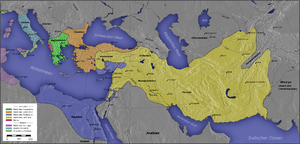
Kingdom of Lysimachus Other
diadochi
Kingdom of
Cassander
Kingdom of
Seleucus_I_Nicator
Kingdom of
Ptolemy
Epirus
Other
Carthage
Rome
Greek
colonies
Feeling that Seleucus was becoming dangerously great, Lysimachus now allied
himself with Ptolemy, marrying his daughter
Arsinoe II of Egypt
. Amastris, who had divorced herself from him, returned
to Heraclea. When Antigonus’s son
Demetrius I of Macedon
renewed hostilities (297 BCE), during his absence in
Greece
,
Lysimachus seized his towns in Asia Minor, but in 294 BCE concluded a peace
whereby Demetrius was recognized as ruler of
Macedonia
. He tried to carry his power beyond the
Danube
, but was
defeated and taken prisoner by the
Getae
king
Dromichaetes
(Dromihete),
who, however, set him free on amicable terms. Demetrius subsequently threatened
Thrace, but had to retire due to a sudden uprising in
Boeotia
, and
an attack from the king
Pyrrhus
of Epirus
.
In 288 BCE, Lysimachus and
Pyrrhus
in turn invaded
Macedonia
, and drove Demetrius out of the country. Lysimachus left
Pyrrhus
in possession of
Macedonia
with the title of king for around seven months before Lysimachus
invaded. For a short while the two ruled jointly but in 285 BCE Lysimachus
expelled Pyrrhus.
Later
years
Domestic troubles embittered the last years of Lysimachus’s life. Amastris
had been murdered by her two sons; Lysimachus treacherously put them to death.
On his return Arsinoe asked the gift of Heraclea, and he granted her request,
though he had promised to free the city. In 284 BCE Arsinoe, desirous of gaining
the succession for her sons in preference to
Agathocles
(the eldest son of Lysimachus), intrigued against him with the
help of her brother
Ptolemy Keraunos
; they accused him of conspiring with Seleucus to seize the
throne, and he was put to death.
This atrocious deed of Lysimachus aroused great indignation. Many of the
cities of Asia revolted, and his most trusted friends deserted him. The widow of
Agathocles fled to Seleucus, who at once invaded the territory of Lysimachus in
Asia. In 281 BCE, Lysimachus crossed the
Hellespont
into Lydia
, and at the decisive
Battle of Corupedium
was killed. After some days his body was found on the
field, protected from birds of prey by his faithful dog.
Lysimachus’s body was given over to his son
Alexander
, by whom it was interred at
Lysymachia
.
|













